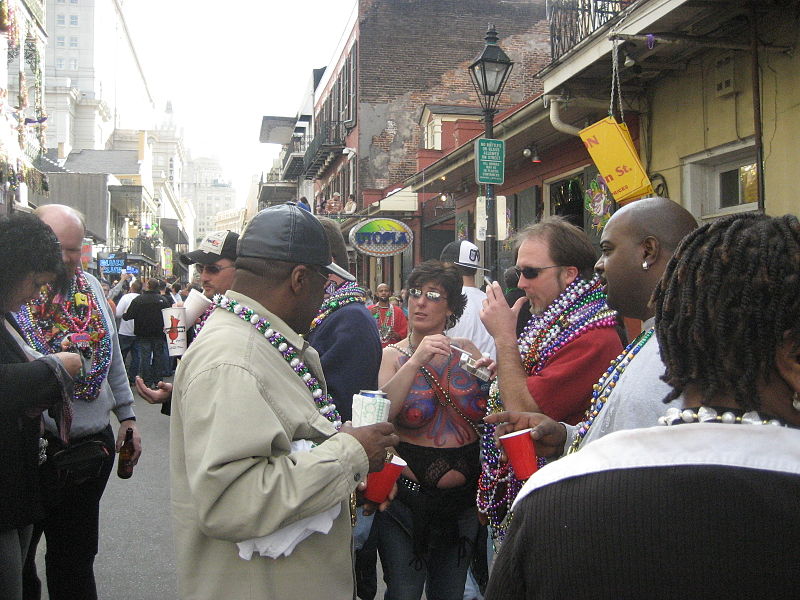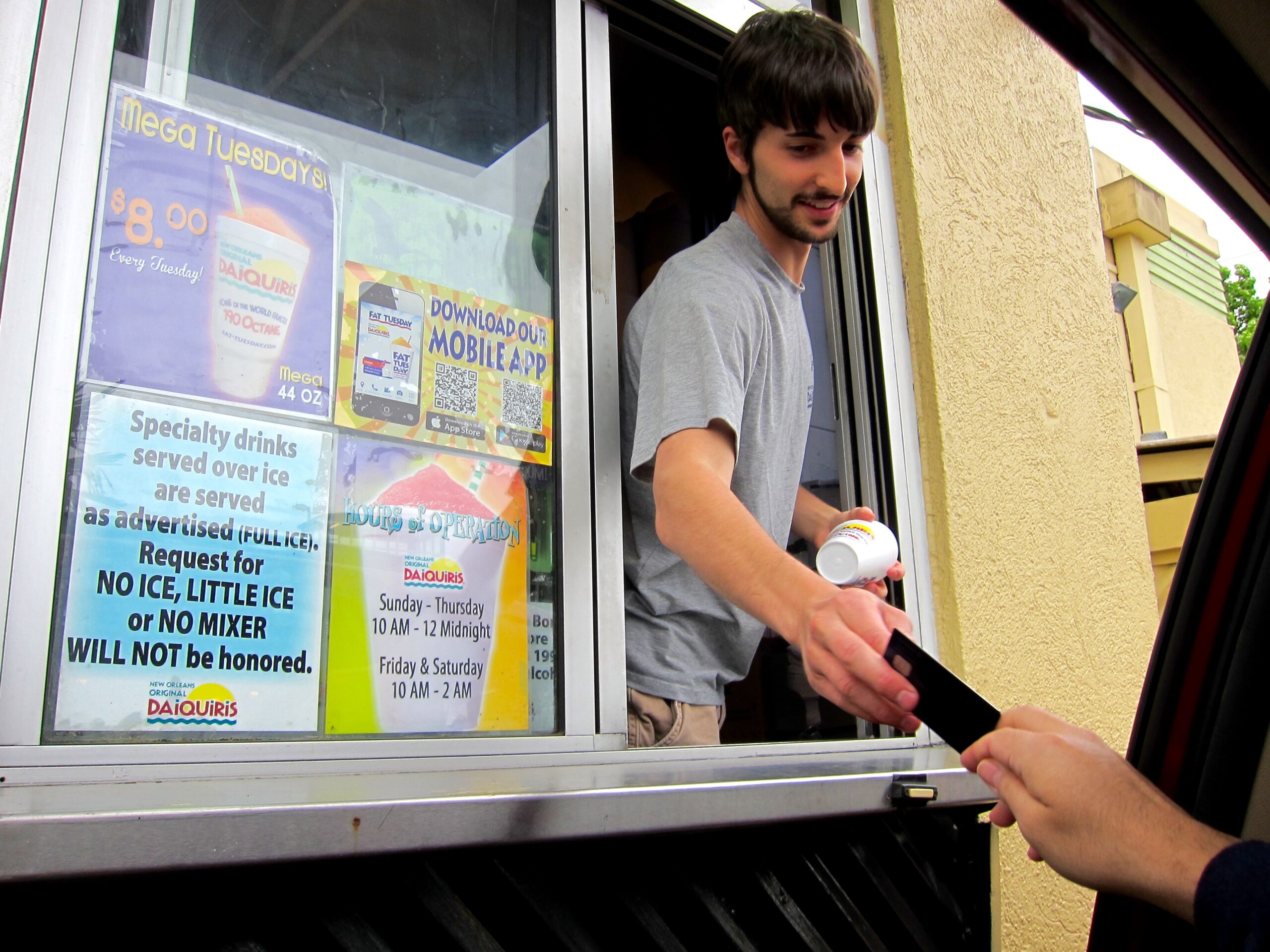Saints game tailgate? Reason to drink at noon. Mardi Gras season? Free pass to pound shots for six weekends in a row. Tough day at the office? Drive through New Orleans Original Daiquiris and pick up a frozen strawberry beverage on the way home from work.
These Big Easy staples are made possible through the New Orleans Municipal Code Sec. 54-404, a.k.a The Open Container Law. This law, radical sounding to those from more conservative areas of the U.S., actually used to be the norm nationwide. Drinking outside was typical in the 19th century with working-class men having their ladies fetch them a pail of beer to enjoy with comrades on their lunch break. However, once the 1950s rolled around, outdoor drinking began to get out of hand. ‘Bottle gangs’ of single men would get drunk and start fights, leaving bottles of beer on the curb. Chicago, making public safety a priority, passed a law in 1953 to ban “drinking in the public way.” Other cities followed suit, associating public drinking with seedy and disruptive behavior. New Orleans did the opposite.
As other cities worked to clean up their streets and rein in the ‘lowlifes,’ Bourbon St. became a hub for anyone and everyone. At first, the city banned window-hawking, or selling inside drinks to customers outdoors, but later reversed that decision, allowing for public alcohol consumption in the French Quarter and later the entire city in the 1970s. The city drew in tourists looking to let loose. New Orleans capitalized on the hippie culture of the 1960s and a flood of tourists post-WWII, embracing its reputation as a party city. “The destination is the key to the experience everywhere else,” says New Orleans drink historian Elizabeth Pearce. “In New Orleans, the journey is equally relevant, and in some cases, there’s no destination. The street itself becomes the show, and everyone is strolling around with a drink in their hand.” This go-with-the-flow, lively atmosphere that Pearce describes has deeper consequences that go beyond a hand grenade in one hand and a hurricane in the other. Drive-through daiquiris are at the root of a dangerous alcohol culture.

Mardi Gras eve celebrants on Bourbon St. (Photo by: Jeffrey Schwartz)
In 2000, 48 percent of Louisiana’s 454 traffic fatalities were tied to alcohol, according to Mothers Against Drunk Driving (MADD). Four years later, Louisiana passed a law to make it illegal for passengers to have open containers of alcohol. But the drive-through daiquiri and poor driving prevailed. Louisiana continues to rank among the nation’s worst drivers according to insurance company surveys.
Drive-through daiquiri locations are required to hand customers a ‘closed container’ with a lid and straw. They put trust in their customers to not pierce the lid until they arrive at their location. New Orleans locals were not happy with the state’s need to enforce this logistical stringency. One customer responded to a city suburb’s debate on ‘open’ daiquiris in cars by saying, “I keep an unused straw in my car. If I get stopped, I just whip out the used one and show them the new one. Looks like a closed container then.” Another customer commented on the debate for ‘closed’ daiquiri containers that “you’re messing with our culture.”

A customer purchases a New Orleans Original Daiquiri through the drive-through. (Photo by: minifastcar33)
Caroline Senter is a local New Orleanian with first-hand experience of the tragedies that alcohol consumption can cause. Senter’s older sister Sudie was killed by a drunk driver while riding her bike in 1978. There were few penalties then for killing someone while drunk and alcohol abuse was a little-known or discussed mental illness. Senter, a recovering alcoholic herself, reflected that little has changed in the way the city has addressed alcohol use.
Even after a drunk driver killed two cyclists in early 2019, the city quickly returned to normal. Just one day after the tragedy occurred on Esplanade St., “Dozens of people filtered in and out… carrying cases of beer.” Next door, “diners sat outside enjoying brunch with champagne.” One block down, “people sat on the patio, sipping margaritas.” A neighbor said, “There’s this attitude, let me get stinking, splash, trash drunk.”
Along with being one of the biggest party cities, New Orleans is also one of the most violent. Young people are consistently experiencing traumatic events, fueling their likelihood to abuse drugs and perpetuate the cycle of drug dealing that runs rampant throughout the city. Additionally, 10% of Louisianans have a diagnosable alcohol use disorder. New Orleans’s lax drinking laws and culture are fueling those already prone to addiction by normalizing their extreme behavior.
One Louisiana lawmaker, Senator Eric Lafleur, is trying to lower the drinking age further with a Louisiana Alcohol Consumption Certificate. The certificate is awarded after completion of a program that educates on the health risks of alcohol consumption. “I really believe that 18-year-olds should be able to drink,” LaFleur told reporters with the LSU Manship School News Service. “It just doesn’t make any sense for people to be going to bars and getting drinks from older guys and having to patrol and regulate that. It just doesn’t work, and everyone knows it doesn’t work. So why do we bury our head in the sand and say it works?”
Alcohol makers are specifically targeting these young, vulnerable populations. A 2020 study in the Journal of Preventive Medicine described how alcohol marketers are using social media ads to target children. Although the ads are not allowed to be directly targeted to kids, because of social media sites’ rules, the ads consistently depict alcohol as fun and adventurous, tailored to a childlike sense of curiosity. The alcopop is central to this debate as well. These sweet, brightly colored drinks draw in adolescents because of their taste. Pinnacle Vodka even has a line of dessert alcohol including Cake, Salted Caramel, and Chocolate Whipped flavors. Cupcake vodka has cupcake-flavored beverages in Frosting, Chiffon, and Devil’s Food varieties. Teenage girls specifically are targeted by ads for sweet-flavored alcoholic beverages.
Those who begin drinking early in life run a greater risk of developing serious alcohol problems, including alcoholism, later in life. David Jernigan, the director of the Center on Alcohol Marketing and Youth (CAMY), said that “at least 14 studies have found that the more young people are exposed to alcohol advertising and marketing, the more likely they are to drink or, if already drinking, to drink more.” Poor school performance and risky sexual activity are also tied to the consumption of alcohol at a young age. New Orleans also lacks public mental health resources, exacerbating already present issues of substance abuse.
New Orleans’ healthcare infrastructure was devastated when Hurricane Katrina ravaged the city on August 29, 2005, and has had a difficult time bouncing back. Mental health resources, in particular, are extremely lacking, and are considered a ‘crisis’ by the media and mental health organizations. Former Governor Bobby Jindal closed New Orleans Adolescent Hospital in 2009, promising that inpatient services would continue at Southeast Louisiana State Hospital. However, Jindal closed that hospital in 2012. The expansion of state Medicaid in 2016 brought health insurance, including mental health coverage to over 400,000 more people in Louisiana. However, there is still a struggle to get doctors to accept Medicaid as well as private mental health providers requiring out-of-pocket payments.
New Orleans’s lack of mental health resources coupled with a raging binge-drinking culture is a recipe for disaster. While we all enjoy a fun night on Bourbon St. every once in a while, I urge people to consider the ill effects of open container laws and how these effects can have far-reaching consequences.
This piece was edited by Lily Plowden as part of Professor Kelley Crawford’s Digital Civic Engagement course at Tulane University.
 NOLAbeings
Multimedia artist Claire Bangser created NOLAbeings as a portrait-based story project that marries...
NOLAbeings
Multimedia artist Claire Bangser created NOLAbeings as a portrait-based story project that marries...
 Data corner: Adobe Suite (create a PDF, social media graphic, presentation, edit a photo and video
Data corner is where you go to work with analytics and top tech skills. It takes on everything from PERL and SQL to Canva and Sprout Social.
Data corner: Adobe Suite (create a PDF, social media graphic, presentation, edit a photo and video
Data corner is where you go to work with analytics and top tech skills. It takes on everything from PERL and SQL to Canva and Sprout Social.

New Orleans really knows how to mix culture, celebration, and flavor into everyday life! From Mardi Gras weekends to drive-thru daiquiris, it’s all about enjoying the moment. It actually reminds us of the fun and flavor we bring across different menus — bold Italian dishes on the Carrabba’s menu, delicious options on the Cheesecake Factory menu, tropical blends on the Tropical Smoothie menu, and full listings over at MenusPricesPHL. Great post — definitely captures the spirit of New Orleans!
These Loaded Taco Sweet Potato Sliders look amazing! The Whole30-friendly ingredients and bold flavors remind us of the clean and tasty dishes we highlight on our menus — like Carrabba’s: https://www.carrabbasmenu.us, Tropical Smoothie: https://tropicalsmoothiemenu.us, and Cheesecake Factory: https://www.cheesecakefactorymenu.us. Definitely going to try these at home!
Thanks for sharing—great post! Really appreciate it. Looking forward to more of your writing—keep it up!https://mcdmenu.com.au/
This is a good and recommendable article, ideal f or reading about efficient pricing strategies and their application in various industries. chick-fil-a
This is a good and recommendable article, ideal for reading about efficient pricing strategies and their application in various industries. For more details, you can explore additional resources on MenusPricesPHL
“
This article was a pleasure to read! Your way of making things clear and interesting is admirable. I suggest you to try Chick Fil A
While the idea of public drinking might seem radical to some, I appreciate the explanation that it used to be much more Traffic Jam 3D. The historical anecdote about “pales of beer” for lunch breaks paints a vivid picture of a different era.
This is a fascinating look at the history and cultural context of open container laws in New Orleans!